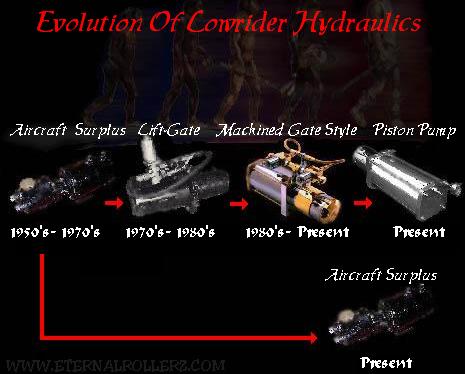
Hydraulics General
Hydraulics in lowriders started out sometime in the 1950's with surplus aircraft hydraulic systems. Aircraft setups were very popular until about the 1970's when parts were getting hard to find. Lowriders started using lift gate pumps from the back of loading trucks on their cars. During the 1980's some shops started making their own pumps for lowriders based on the early lift gate pump design. Eventually features such as air valves and pressure plates were added to the pumps. Those features are on pumps that are used today.

Hydraulic Cylinders:
Pressure (Psi) = Force (lbf) / Area (in2)
Cylinder speed (ft/s) = 231 x GPM / (720 x net area (in2))
Cylinder volume capacity (Gal.) = Pi x radius2 (inches) x stroke (inches) / 231
Oil flow rate to cylinder = 720 x velocity (ft/s) x net area (square inches)
Hydraulic Reservoirs:
Hydraulic reservoir sizing: One gallon of capacity per one GPM of pumping capacity.
Reservoirs should be tall and narrow rather than short and wide so as to reduce vortex effects and improve heat dissipation.
Hydraulic Pumps & Motors:
Pumping: 1 Hp = 1 GPM x 1500 Psi (linear relationship i.e. 2 GPM @ 1500 Psi = 2 Hp)
Displacement (in3 / rev) = GPM x 231 /RPM
Hp to drive hydraulic pump = Psi x GPM / 1714
Typically assume hydraulic pump/motor efficiency of 85%
Hydraulic motor torque (in-lb) = Pressure (Psi)
x motor displacement (in3/rev) / (2 x Pi)
Hydraulic motor speed (RPM)= 231 x GPM / motor displacement (in3/rev)
Hydraulic motor power (Hp) = Torque (in-lb) x RPM / 63025
Hydraulic Valve Terms:
Open-center, open-center-power-beyond and closed-center are terms used to describe hydraulic valves in the neutral position.
Open-Center: Typically used with a fixed-displacement pump, allows oil to free-flow back to the tank in neutral position. Shifting the spool redirects oil to the selected work port.
Open-Center-Power-Beyond: Same as Open-Center valve except oil flows to downstream circuit in the neutral position instead of returning to the tank.
Closed-Center: Typically used with a variable-displacement pump, oil flow is blocked at the valve until the spool is shifted from neutral.
Motor-spool: In the neutral position fluid is allowed to flow back to the tank. This allows the operator to run a hydraulic motor under load and, when the valve is shifted to stop flow to the motor, allows the motor to coast to a stop.
Cylinder-spool: In the neutral position fluid is blocked from flowing to the tank. This effectively locks the load in place and should be used in applications where a load is to be raised and held aloft with a hydraulic cylinder.
Three-way valve: Typically used to control single-acting circuits
Four-way valve: Typically used to control double-acting circuits
All Photographs and Art Copyright
© 1998-2005 Eternal Rollerz C.C.
Website Design Copyright © 1998-2005 Webmaster